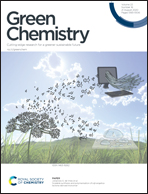Calix[8]arene-constructed stable polyoxo-titanium clusters for efficient CO2 photoreduction†
Abstract
It is still rare for coordination complexes to achieve CO2 reduction reaction in water. Demonstrated here is the self-assembly and CO2 photoreduction performance of two thermodynamically reversibly converted polyoxo-titanium clusters (PTCs), Ti4-C8A and Ti7-C8A, using calix[8]arene with high molecular degrees of freedom and variable conformations as an organic “functional armor”. Because of the rich coordination sites and bridging modes of calix[8]arene, the obvious electron transfer effect generated between the titanium–oxo core and calix[8]arene ligand extended the light absorption of the two PTCs from the traditional ultraviolet to the visible region. Moreover, the hydrophobic benzene groups in calix[8]arene endowed the two clusters with high structural and chemical stability in aqueous solutions with different pH values. On this foundation, these two stable and photosensitive clusters were used as heterogeneous molecular photocatalysts for efficient CO2 reduction in water (with triethanolamine as a sacrificial agent) and they exhibited very high CO2-to-HCOO− conversion activity and selectivity. Most importantly, this is the first report of molecular coordination complexes in water containing a sacrificial agent to perform heterogeneous CO2 reduction reaction.
![Graphical abstract: Calix[8]arene-constructed stable polyoxo-titanium clusters for efficient CO2 photoreduction](/en/Image/Get?imageInfo.ImageType=GA&imageInfo.ImageIdentifier.ManuscriptID=D0GC01497D&imageInfo.ImageIdentifier.Year=2020)
- This article is part of the themed collection: CO2 Utilisation


 Please wait while we load your content...
Please wait while we load your content...